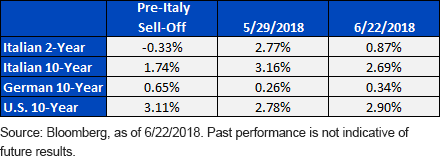Sovereign Debt Yields: Like a Day at Six Flags


Looking at recent developments in the developed world’s sovereign debt markets, an investor could be excused for feeling like they are on a roller-coaster ride. Indeed, from the beginning of May through the third week of June, market participants witnessed surging U.S. Treasury (UST) 10-Year yields, followed by chaos in the Italian bond market, which led to some noteworthy flight-to-quality trades in both the U.S. and Germany.
But the first headline-grabbing event came in the UST arena. To be sure, the 10-Year yield finally broke through a key technical level (3.05%) to post its highest reading since 2011. Interestingly, this “new peak” did not last long, as once again, developments out of the eurozone rattled global bond markets.
This time around, the bad news came from Italy. The new Italian government that was forming was viewed as being made up of “euroskeptics.” The ensuing concern centered around conjecture about Italy possibly leaving the eurozone (sound familiar?) or, at the very least, endorsing a budget that would essentially abrogate the European Union’s spending rules and potentially subvert the treaty that led to the euro’s creation. In addition, there were reports the governing coalition might pursue cancellation of €250 billion in Italian bonds held by the ECB.
Recent Changes in Selected Sovereign Debt Yields

Needless to say, cooler heads prevailed, at least in the short run. However, the damage had been done, and the global bond market went through said roller-coaster ride. Let’s take a look at Italian sovereign debt yields first. Without a doubt, the largest swings occurred in the 2-year sector, where yields surged from -0.33% to a high of 2.77% by the end of May, an eye-opening swing of 310 basis points (bps). In fact, at the height of investor anxiety, the Italian 2-year yield exploded by nearly 190 bps in just one trading session. The 10-year maturity did not escape the selling pressure and registered its own increase of 142 bps during the month. In each instance, some of the market’s worst fears were not realized, so yields dropped precipitously in both cases—but the levels are still well above their early May starting points (see chart) as of this writing.
Meanwhile, the U.S. and German bond markets were the beneficiaries of the safe-haven trade that resulted from the turbulence in Italy. At one point, the UST 10-Year yield dropped over 30 bps from its 3.11% peak, with the German bund of the same maturity recording a similar trajectory. In a mirror image to the Italian sovereign episode, both the U.S. and German 10-year yields still reside below the levels that prevailed prior to the eurozone fears.
Conclusion
Where does that leave us? As I mentioned, while the markets’ worst fears did not materialize, it appears as if the situation in Italy and its potential knock-on effects for the eurozone as well as the financial sector have not been removed. The new Italian government is still viewed with trepidation. Interestingly, despite the ECB’s bold policy attempts at stabilizing the eurozone, the underlying problems that have plagued investors’ confidence apparently have not gone away. While a rate hike on the other side of the Atlantic does not seem to be forthcoming anytime soon, the ECB did announce its intention to end its quantitative ease program by the end of this year, removing one of the “whatever it takes” supporting measures in the process.
Unless otherwise stated, all data source for this blog is Bloomberg, June 22nd 2018.


